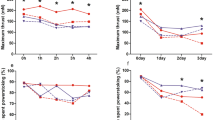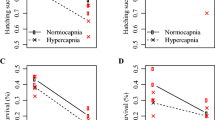Abstract
In an experiment repeated for two separate years, incubation temperature was found to affect the body size and swimming performance of hatchling green turtles (Chelonia mydas). In the first year, hatchlings from eggs incubated at 26°C were larger in size than hatchlings from 28 and 30°C, whilst in the second year hatchlings from 25.5°C were similar in size to hatchings from 30°C. Clutch of origin influenced the size of hatchlings at all incubation temperatures even when differences in egg size were taken into account. In laboratory measurements of swimming performance, in seawater at 28°C, hatchlings from eggs incubated at 25.5 and 26°C had a lower stroke rate frequency and lower force output than hatchlings from 28 and 30°C. These differences appeared to be caused by the muscles of hatchlings from cooler temperatures fatiguing at a faster rate. Clutch of origin did not influence swimming performance. This finding that hatchling males incubated at lower temperature had reduced swimming ability may affect their survival whilst running the gauntlet of predators in shallow near-shore waters, prior to reaching the relative safety of the open sea.









Similar content being viewed by others
References
Booth DT, Astill K (2001a) Incubation temperature, energy expenditure and hatchling size in the green turtle (Chelonia mydas), a species with temperature-sensitive sex determination. Aust J Zool 49:389–396
Booth DT, Astill K (2001b) Temperature variation within and between nests of the green sea turtle, Chelonia mydas (Chelonia: Cheloniidae) on Heron island, Great Barrier Reef. Aust J Zool 49:71–84
Booth DT, Burgess E, McCosker J, Lanyon JM (2004) The influence of incubation temperature on post-hatching fitness characteristics of turtles. Int Congr Ser 1275:266–233
Braña F, Ji X (2000) Influence of incubation temperature on morphology, locomotor performance, and early growth of hatchling wall lizards (Podarcis muralis). J Exp Zool 286:422–433
Broderick AC, Godley BJ, Hays GC (2001) Metabolic heating and the prediction of sex ratios for green turtles (Chelonia mydas). Physiol Biochem Zool 74:161–170
Burger J (1990) Effects of incubation temperature on behaviour of young black racers (Coluber constrictor) and kingsnakes (Lampropeltis getulus). J Herpetol 24:158–163
Burger J (1991) Effects of incubation temperature on behaviour of young pine snakes: implications for reptile distribution. Behav Ecol Sociobiol 28:297–303
Bustard R (1972) Sea turtles, natural history and conservation. Collins, London
Deeming DC (2004) Post-hatching phenotypic effects of incubation in reptiles. In: Deeming DC (ed) Reptile incubation: environment, evolution and behaviour. Nottingham University press, Nottingham, pp 229–252
Doody JS (1999) A test of the comparative influences of constant and fluctuating incubation temperatures on phenotypes of hatchling turtles. Chelonian Conserv Biol 3:529–531
Downes SJ, Shine R (1999) Do incubation-induced changes in a lizard’s phenotype influence its vulnerability to predators? Oecologica 120:9–18
Du W-G, Ji X (2003) The effects of incubation thermal environments on size, locomotor performance and early growth of hatchling soft-shelled turtles, Pelodiscus sinensis. J Therm Biol 28:279–286
Formia A (1996) Effects of global temperature increase on the viability of loggerhead sea turtles (Caretta caretta) at Melbourne Beach, Florida. In: Keinath JA, Barnard DE, Musick JA, Bell BA (eds) Proceedings of the fifteenth annual workshop on sea turtle biology and conservation, 100 NOAA Technical Memorandum NMFS-SEFSC-387, pp 88–92
Godfrey MH, Mrosovsky N (1997) Estimating the time between hatching of sea turtles and their emergence from the nest. Chelonian Conserv Biol 2:581–585
Godfrey MH, Barreto R, Mrosovsky N (1996) Sex ratios of sea turtles in Suriname: past and present. In: Keinath JA, Barnard DE, Musick JA, Bell BA (eds) Proceedings of the fifteenth annual workshop on sea turtle biology and conservation, 100 NOAA Technical Memorandum NMFS-SEFSC-387, pp 98–103
Gyuris E (1994) The rate of predation by fishes on hatchlings of the green turtle. Coral Reefs 13:137–144
Gyuris E (2000) The relationship between body size and predation rates on hatchlings of the green turtle (Chelonia mydas): is bigger better? In: Pilcher NJ, Ismail MG (eds) Sea turtles of the Indo-Pacific: research, management and conservation. Academic, New York, pp 143–147
Harry JL, Limpus CJ (1989) Low temperature protection of marine turtle eggs during long distance relocation. Aust Wildl Res 16:317–320
Hendrickson JR (1980) The ecological strategies of sea turtles. Am Zool 20:597–608
Janzen FJ (1993) The influence of incubation temperature and family on eggs, embryos and hatchlings of the smooth softshelled turtle (Apalone mutica). Physiol Zool 66:349–373
Limpus CJ, Reed P, Miller JD (1983) Islands and turtles. The influence of choice of nesting beach on sex ratio. In: Baker JT, Carter RM, Sammarco PW, Stark KP (eds) Proceedings: inaugural Great Barrier Reef conference. James Cook University Press, Townsville, pp 397–402
Limpus CJ, Fleay A, Guinea M (1984) Sea turtles of the Capricornia section. In: Ward WT, Saenger P (eds) The Capricornia section of the Great Barrier Reef: past, present and future. Royal Society of Queensland and Australian Coral Reef Society, Brisbane, pp 61–78
Lindeman RH, Merenda PF, Gold R (1980) Introduction to bivariate and multivariate analysis. Scott, Foreman and Co, New York
Miller JD (1997) Reproduction in sea turtles. In: Lutz P, Musick JA (eds) The biology of sea turtles. CRC, New York, pp 52–81
Miller JD, Limpus CJ (1981) Incubation period and sexual differentiation in the green turtle Chelonia mydas. In: Banks CB, Martin A (eds) Proceedings of the Melbourne herpetological symposium. The Royal Botanical Gardens, Melbourne, pp 66–73
Packard GC, Packard MJ (1993) Sources of variation in laboratory measurements of water relations of reptilian eggs and embryos. Physiol Zool 66:115–127
Pilcher NJ, Enderby JS (2001) Effects of prolonged retention in hatcheries on green turtle (Chelonia mydas) hatchling swimming speed and survival. J Herpetol 35:633–638
Rhen T, Lang JW (2004) Phenotypic effect of incubation temperature in reptiles. In: Valenzuela N, Lance V (eds) Temperature-dependent sex determination in vertebrates. Smithsonian Books, Washington, pp 90–98
Richardson JI (1999) Priorities for studies of reproduction and nest biology. In: Ecker KL, Bjorndal KA, Abreu-Grobois FA, Donnelly M (eds) Research and management techniques for the conservation of sea turtles. IUCN/SSC Marine Turtle Specialist Group publication no. 4, pp 9–11
Salmon M, Wyneken J (1987) Orientation and swimming behaviour of hatchling loggerhead turtles Caretta caretta L. during their offshore migration. J Exp Mar Biol Ecol 109:37–153
Shine R, Elphick MJ, Harlow PS (1995) Sisters like it hot. Nature 378:451–452
Sinervo B, Huey RB (1990) Allometric engineering: an experimental test of the causes of interpopulational differences in performance. Science 248:1106–1109
Spotila JR, Standora EA, Morreale SJ, Ruitz GJ (1987) Temperature dependent sex determination in green turtles (Chelonia mydas): effects on the sex ratio on a natural nesting beach. Herpetologica 43:74–81
Spotila JR, Reina RD, Steyermark AC, Plotkin PT, Paladino FV (2000) Pacific leatherback turtles face extinction. Nature 405:529–530
Standora EA, Spotila JA (1985) Temperature dependent sex determination in sea turtles. Copeia 1985:759–764
Van Damme R, Bauwens D, Brana F, Verheyen RF (1992) Incubation temperature differentially affects hatching time, egg survival and sprint speed in the lizard Podarcis muralis. Herpetologica 48:220–228
Webb JK, Brown GP, Shine R (2001) Body size, locomotor speed and antipredator behaviour in a tropical snake (Tropidonophis mairii, Colubridae): the influence of incubation environments and genetics factors. Funct Ecol 15:561–568
Wyneken J, Salmon M (1992) Frenzy and postfrenzy swimming activity in loggerhead, green, and leatherback hatchling sea turtles. Copeia 1992:478–484
Yntema CL, Mrosovsky N (1992) Critical periods and pivotal temperatures for sexual differentiation in loggerhead sea turtles. Can J Zool 60:1012–1016
Acknowledgements
Part of this work was sponsored by the Sea World Research and Rescue Foundation and by the CRC Reef Research Centre Augmentative Research Grant Scheme. Work was carried out under Queensland EPA scientific research permit E5/000100/98/SAA and University of Queensland animal ethics approval ZOO/408/00/H.
Author information
Authors and Affiliations
Corresponding author
Additional information
Communicated by Biology Editor M.I. McCormick
Rights and permissions
About this article
Cite this article
Burgess, E.A., Booth, D.T. & Lanyon, J.M. Swimming performance of hatchling green turtles is affected by incubation temperature. Coral Reefs 25, 341–349 (2006). https://doi.org/10.1007/s00338-006-0116-7
Received:
Accepted:
Published:
Issue Date:
DOI: https://doi.org/10.1007/s00338-006-0116-7




